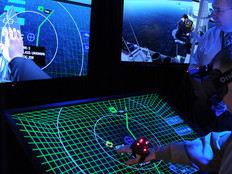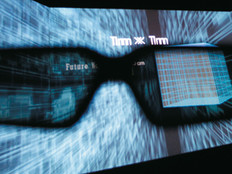Augmented Reality Headsets Promise Navy Divers an ‘Iron Man’ Experience
Iron Man, meet Aquaman. The U.S. Navy is testing a prototype augmented reality diving helmet that will display critical digital information for Navy divers on their missions underwater.
The AR headsets, which have been developed at the Naval Surface Warfare Center, Panama City Division, will give divers visual access to real-time digital information about what they are seeing while on their missions. The new system, dubbed the Divers Augmented Vision Display (DAVD), is a high-resolution, see-through head-up display (HUD) embedded directly inside of a diving helmet, according to a Navy statement.
Dennis Gallagher, an underwater systems development project engineer, has worked with his team to collaborate with and demonstrate the DAVD system to more than 20 divers from various commands who are interested in the futuristic system.
The team is now working on the next phase of the project, in which components are being designed to include both helmet systems and full face masks. Divers are scheduled to conduct simulation testing in the water in October, and phase three will begin in fiscal year 2017 to harden the system for expanded field testing with various dive commands.
Giving Divers Access to Digital Information
AR, which has cropped up on smartphones and tablets, displays digital information over real-world views of physical locations, and can enhance users’ experiences and provide them with contextual information on their surroundings.
This DAVD system gives divers a real-time visual display of everything from sector sonar (a real-time topside view of the diver’s location and dive site), text messages, diagrams, photographs and even AR videos. Divers can turn the display on and off and tell Navy personnel above water to reposition data in different locations on the display.
If divers have that kind of data while they are on their missions, they can be more effective and safe while underwater. The Navy says divers will get “expanded situational awareness and increased accuracy in navigating to a target, such as a ship, downed aircraft, or other objects of interest.”
“Instead of having to rely on predive briefings alone to determine what they are looking for, how specific items should appear and where they may be located, the DAVD system places the information right before divers’ eyes with a look and feel comparable to a point-of-view video game display,” the Navy says.
A Variety of Missions
The Navy envisions the AR displays being used for various diving missions, including ship husbandry and repairs, underwater construction and salvage operations.
Additionally, the Navy thinks that the DAVD could eventually be used by first responders and the commercial diving community.
“By building this HUD directly inside the dive helmet instead of attaching a display on the outside, it can provide a capability similar to something from an ‘Iron Man’ movie,” Gallagher says. “You have everything you visually need right there within the helmet.”
The Navy is working to identify, exploit and develop next-generation diving equipment as part of its strategic plan for 2011–2025. As part of that, the Navy is in the process of developing enhanced sensors — such as miniaturized high-resolution sonar and enhanced underwater video systems — to enable divers to “see” images up close in higher resolution, even when water visibility is near zero. These enhanced underwater vision systems would be fed directly into the DAVD display, the Navy says.
“We constantly engage with the operators; if there is a vision they have, we can make it happen,” Gallagher says. “By having this type of positive on-the-spot feedback, you know you're going down the right road.”








